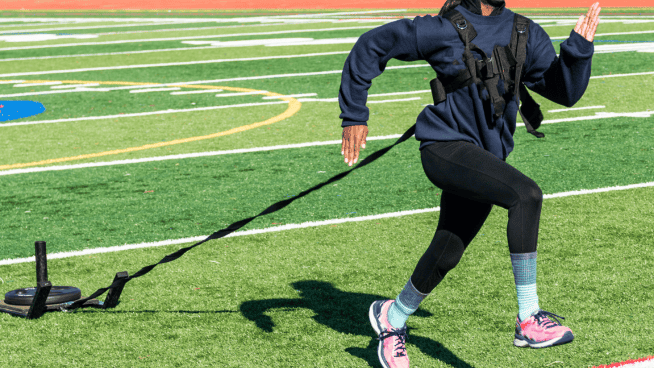How to Find Your Perfect Bench Press Grip
It’s no surprise that the traditional Barbell Bench Press is one of the most notoriously hard exercises on the shoulders. But since we aren’t all competitive powerlifters, there’s no reason to bench like one.
RELATED: Bench Press Grip Guide: How Hand Placement Changes the Exercise
If you are an athlete or just someone who wants to train hard and get strong while looking and feeling better, chances are you’ve been using the wrong grip for your Bench Press for your specific goals and needs.
Remember, strength training is meant to build resiliency and lower the risk of injuries, not leave you more broken down and hurt after every session. Here’s how to optimize your grip width on the Bench Press to get strong, build muscle and protect your shoulders in the process.
Finding The Perfect Grip For Bench Pressing
Here’s how to determine your theoretical “perfect” grip width on the barbell during the Bench Press:
- Stand with your feet positioned shoulder-width apart.
- Extend your arms down to your sides with your thumbs facing the sides of your thighs.
- Extend your thumbs to make contact with the sides of your thighs.
- Note the distance between the index fingers of your two hands.
- This distance is your theoretical perfect grip width for the Barbell Bench Press setup.
Once you’ve determined the distance between your index fingers, it’s time to transfer it to the Bench Press. Simply lie down and grip the bar with a full grip, wrapping your fingers and thumbs around the bar. You’ll be well on your way to a pain-free Bench Press.
RELATED: 10 Bench Press Variations for a Bigger and Stronger Chest
Why This Grip Position Works
Many lifters set up too wide with their grip. This is mainly due to the fact that a vast majority of lifters can use more weight with a wider grip. But heavier weight does not always translate into more strength and muscle, and sometimes it can lead to chronic or traumatic injuries to the shoulders, especially if form is altered and compensation patterns develop.
The theoretical perfect grip is a bit more narrow than many athletes and lifters are used to, but that’s exactly the point. We want to place the shoulders and chest in a more “neutral” position, where we can distribute the force that it takes to press the bar off the chest between the chest, delts and triceps. When more emphasis is placed on the triceps, less stress is placed on the anterior chain muscles (the chest and anterior delts), which are usually the areas where lifters get beat up on the Bench Press.
RELATED: 3 Tricep Exercises That Will Add Serious Weight to Your Bench Press
What does this grip test teach us? Simply put, small alterations on the setup and hand/foot positions on your major lifts can make a huge difference in your ability to perform these staple lifts hard and pain-free. Always err on the side of caution, and when in doubt, grab the bar a little more narrow. Your shoulders will thank you.
RECOMMENDED FOR YOU
MOST POPULAR
How to Find Your Perfect Bench Press Grip
It’s no surprise that the traditional Barbell Bench Press is one of the most notoriously hard exercises on the shoulders. But since we aren’t all competitive powerlifters, there’s no reason to bench like one.
RELATED: Bench Press Grip Guide: How Hand Placement Changes the Exercise
If you are an athlete or just someone who wants to train hard and get strong while looking and feeling better, chances are you’ve been using the wrong grip for your Bench Press for your specific goals and needs.
Remember, strength training is meant to build resiliency and lower the risk of injuries, not leave you more broken down and hurt after every session. Here’s how to optimize your grip width on the Bench Press to get strong, build muscle and protect your shoulders in the process.
Finding The Perfect Grip For Bench Pressing
Here’s how to determine your theoretical “perfect” grip width on the barbell during the Bench Press:
- Stand with your feet positioned shoulder-width apart.
- Extend your arms down to your sides with your thumbs facing the sides of your thighs.
- Extend your thumbs to make contact with the sides of your thighs.
- Note the distance between the index fingers of your two hands.
- This distance is your theoretical perfect grip width for the Barbell Bench Press setup.
Once you’ve determined the distance between your index fingers, it’s time to transfer it to the Bench Press. Simply lie down and grip the bar with a full grip, wrapping your fingers and thumbs around the bar. You’ll be well on your way to a pain-free Bench Press.
RELATED: 10 Bench Press Variations for a Bigger and Stronger Chest
Why This Grip Position Works
Many lifters set up too wide with their grip. This is mainly due to the fact that a vast majority of lifters can use more weight with a wider grip. But heavier weight does not always translate into more strength and muscle, and sometimes it can lead to chronic or traumatic injuries to the shoulders, especially if form is altered and compensation patterns develop.
The theoretical perfect grip is a bit more narrow than many athletes and lifters are used to, but that’s exactly the point. We want to place the shoulders and chest in a more “neutral” position, where we can distribute the force that it takes to press the bar off the chest between the chest, delts and triceps. When more emphasis is placed on the triceps, less stress is placed on the anterior chain muscles (the chest and anterior delts), which are usually the areas where lifters get beat up on the Bench Press.
RELATED: 3 Tricep Exercises That Will Add Serious Weight to Your Bench Press
What does this grip test teach us? Simply put, small alterations on the setup and hand/foot positions on your major lifts can make a huge difference in your ability to perform these staple lifts hard and pain-free. Always err on the side of caution, and when in doubt, grab the bar a little more narrow. Your shoulders will thank you.










